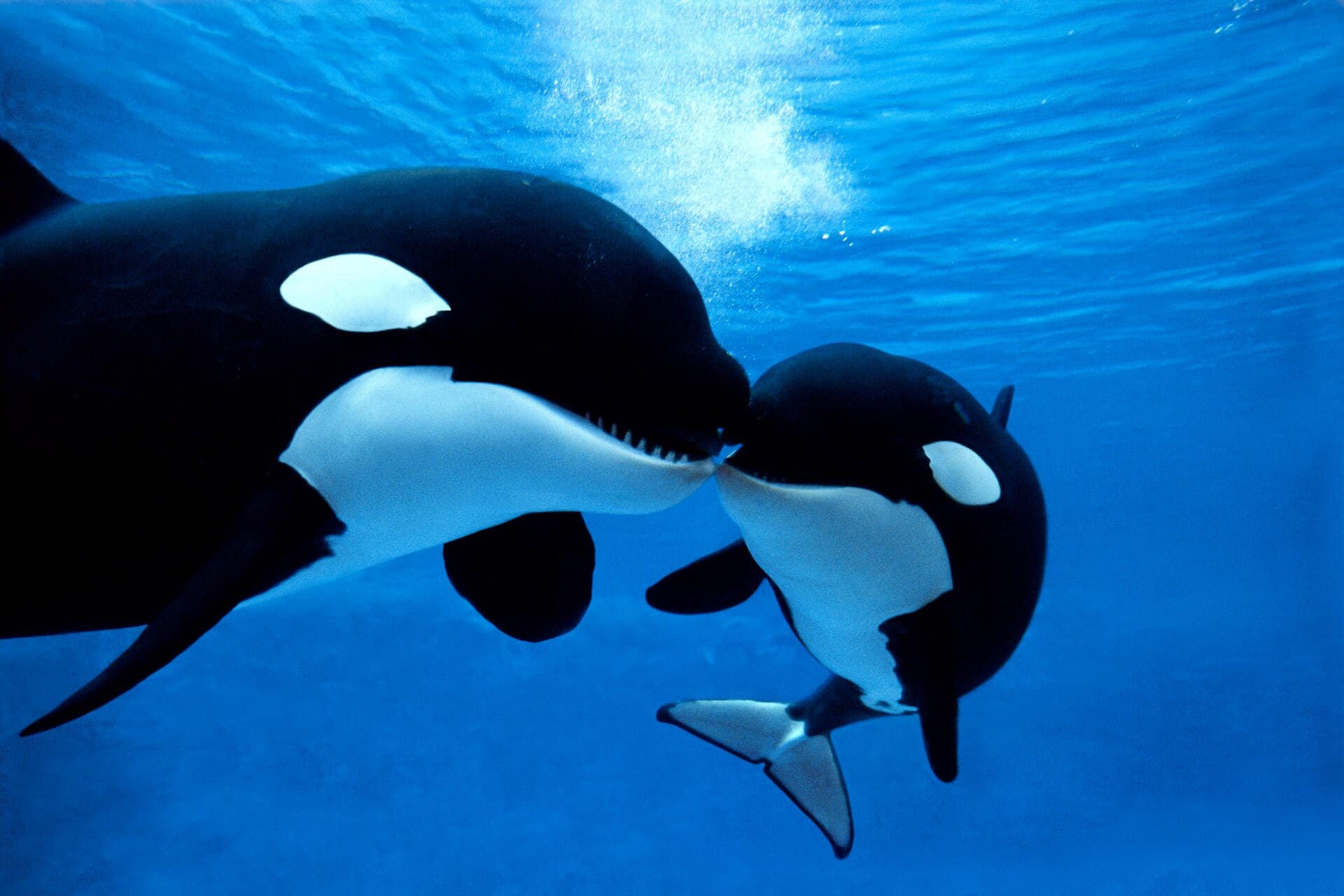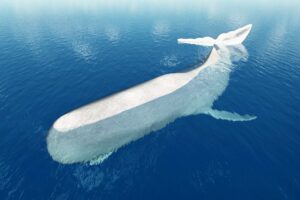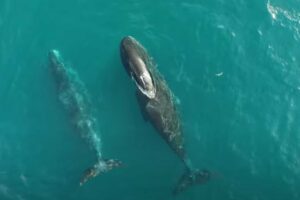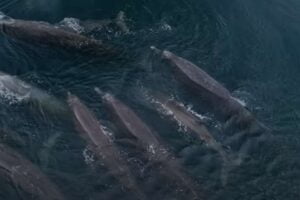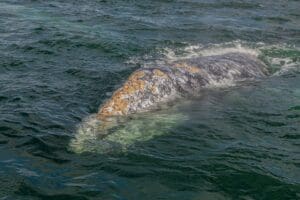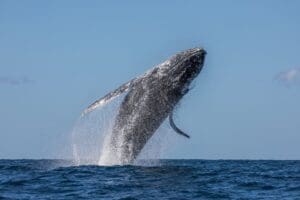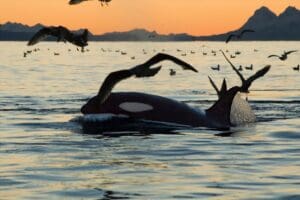Spotlight on Species: Orca Whales in the Wild
If you like sea animals, you’ve probably heard of orca whales or killer whales. They’re cool and interesting, and many people are amazed by them. Orcas look unique and have a special way of living together in groups.
In this article, we’ll look closer at orca whales and explore what makes them such fascinating creatures.
Fascinating Facts about Orcas (Killer Whales)


Are orcas and killer whales the same?
Yes, orcas and killer whales are the same species, known scientifically as Orcinus orca. The term “killer whale” stems from their reputation as formidable predators, while “orca” is derived from their scientific name.
Why is orca called Killer?
Orcas were dubbed “killer whales” by ancient sailors who observed them hunting in groups to take down large whales, earning them the moniker “whale killers,” which eventually flipped to “killer whales.”
Are orcas friendly to humans?
Orcas generally exhibit curiosity and sometimes playful behavior around humans, especially in the wild. There have been numerous accounts of orcas interacting peacefully with humans, though they are wild animals with individual personalities.
Are orcas dangerous to humans?
While orcas are powerful predators, there are no confirmed reports of wild orcas fatally attacking humans. Incidents involving orcas and humans have primarily occurred in captivity.
Why don’t orcas attack humans?
The reason why wild orcas don’t attack humans remains a subject of speculation among scientists. Some suggest it’s due to their social structure and diet, while others believe orcas may simply not view humans as prey.
Are orcas dolphins or whales?
Orcas are part of the oceanic dolphin family, making them the largest members of the dolphin family, despite often being referred to as whales due to their size.
Are orcas endangered?
Some orca populations are indeed endangered, particularly those affected by pollution, reduced prey availability, and habitat destruction. Conservation status can vary significantly between different orca communities.
How many orca are left?
Estimating the global orca population is challenging due to their widespread distribution, but certain populations, like the Southern Resident killer whales, are known to be critically endangered with just over 70 individuals remaining.
Are orcas carnivores?
Yes, orcas are apex predators and carnivores, feeding on a diet that includes fish, seals, and sometimes whales.
What do orca eat?
Orcas have diverse diets that can include fish, squid, seals, sea lions, penguins, and even larger whales, depending on their habitat and social group.
Can orcas kill humans?
While capable of causing harm due to their size and strength, there is no record of a wild orca killing a human.
Can orcas eat humans?
There are no documented cases of orcas eating humans, and humans are not naturally included in their diet.
Is it OK to swim with orcas?
Swimming with wild orcas is not recommended due to the potential risks involved in interacting with wild predators, despite their generally non-aggressive behavior towards humans.
Can orcas kill sharks?
Yes, orcas are known to prey on sharks, including great whites, using sophisticated hunting techniques to immobilize them.
Can orcas live in freshwater?
Orcas are marine mammals adapted to saltwater environments. While they can enter freshwater for short periods, they cannot live in it permanently.
Are killer whales smart?
Yes, killer whales (orcas) are among the most intelligent marine mammals, known for their complex social structures, hunting strategies, and ability to learn and solve problems.
What is an orcas IQ?
While it’s challenging to quantify animal intelligence with a human metric like IQ, orcas are considered highly intelligent, exhibiting complex social behaviors and problem-solving abilities.
Is an orca smarter than a monkey?
Comparing intelligence across species is complex, but orcas are recognized for their high cognitive abilities, comparable to those of primates in terms of social structure and problem-solving skills.
Are orcas smarter than dogs?
Orcas display a level of social intelligence and problem-solving ability that is highly sophisticated, arguably exceeding that of dogs, though direct comparisons are difficult due to the different ways intelligence can manifest.
Why are killer whales so smart?
The intelligence of killer whales is thought to be linked to their complex social interactions, communication, and the need to cooperatively hunt varied prey, which requires sophisticated problem-solving skills.
How fast are orcas?
Orcas are powerful swimmers, capable of reaching speeds up to 34 miles per hour (55 kilometers per hour) in short bursts when hunting or traveling.
How do orcas protect themselves?
Orcas rely on their size, speed, and social groups to protect themselves from threats. Their cooperative hunting strategies also play a role in their defense.
Are killer whales deaf?
No, killer whales are not deaf. They have highly developed hearing suited for both air and water, which is essential for echolocation and communication.
Do whales cry fat?
The concept of whales “crying fat” is a misunderstanding. Whales do not cry in the human sense, and any secretion from their eyes would not be fat.
How do orcas sleep?
Orcas sleep by resting one hemisphere of their brain at a time, allowing them to continue breathing consciously and remain partially alert to their environment.
How do orcas mate?
Orcas mate through a process where the male swims upside down under the female, aligning their bodies for copulation. Mating behaviors can vary among different populations.
How do orcas hunt?
Orcas use sophisticated hunting techniques that can include herding fish, beaching themselves to catch seals, or using waves to knock prey off ice floes, often working cooperatively in pods.
Can orcas say hello?
While orcas cannot say “hello” in human language, they have been trained in captivity to mimic certain sounds, and they use complex vocalizations to communicate within their pods.
Do orcas have a language?
Orcas have highly complex vocalizations that can be considered a form of language, with different pods having distinct dialects used for communication.
How do orcas communicate?
Orcas communicate through a variety of sounds, including clicks, whistles, and pulsed calls, which are believed to convey information, coordinate hunting, and maintain social bonds.
How do orcas reproduce?
Orcas reproduce sexually, with females giving birth to live young after a gestation period of approximately 17 months. Reproductive behaviors and timing can vary among populations.
Can orcas lay eggs?
No, orcas are mammals and give birth to live young rather than laying eggs.
Should orcas be kept in captivity?
The captivity of orcas is highly controversial due to concerns about their well-being, complex social structures, and need for large territories, leading many to argue against it.
Can orcas hear music?
Orcas have sensitive hearing and can perceive sound frequencies in water, which suggests they might respond to music played through underwater speakers, though their perception of music is not well understood.
Do orcas have friends?
Orcas form strong social bonds within their pods, which can be likened to friendships, with individuals often showing preferences for certain companions.
Did orcas evolve from wolves?
No, orcas did not evolve from wolves. They are marine mammals that share a common ancestor with other cetaceans, separate from the evolutionary lineage of wolves.
Did orcas have legs?
Like all cetaceans, orcas evolved from land-dwelling ancestors with legs. Over millions of years, they adapted to an aquatic lifestyle, leading to the loss of external hind limbs.
When do orcas migrate?
Orcas do not have a fixed migration pattern like some whale species but may move seasonally in response to prey availability or breeding activities.
Where are orcas found?
Orcas are found in all oceans, from the Arctic and Antarctic regions to tropical seas, making them one of the most widely distributed marine mammals.
Which orca killed its trainer?
Several incidents have occurred involving orcas and trainers, with the most notable being the death of trainer Dawn Brancheau in 2010 by the orca Tilikum at SeaWorld Orlando.
The tragic incident involving Dawn Brancheau and the orca Tilikum at SeaWorld Orlando in 2010 has been attributed to a combination of factors. Tilikum, a large male orca who had been involved in two previous incidents, pulled Brancheau into the water during a live performance. The reasons behind this behavior are complex and multifaceted, involving the orca’s history, the conditions of captivity, and the nature of the interactions between orcas and trainers.
Experts and documentaries, such as “Blackfish,” have suggested that the psychological and physical stress of captivity on such intelligent and social creatures can lead to unpredictable and sometimes aggressive behavior. Orcas in the wild cover vast distances, live in complex social structures, and engage in behaviors that cannot be replicated in captivity. The stress of confinement, along with Tilikum’s history of being captured at a young age and his experiences in various marine parks, may have contributed to the tragic event.
It’s important to note that there are no recorded cases of orcas attacking humans in the wild, which further underscores the argument that captivity can have detrimental effects on these highly intelligent animals. The incident led to widespread scrutiny of orca captivity and has prompted changes in how marine parks operate, including the cessation of breeding orcas in captivity and the phasing out of live orca shows at SeaWorld.
Understanding Orca Whales
What Makes Orcas Unique?
Orcas, often known as killer whales, are among the most distinctive and easily recognizable marine creatures. Their unique physical characteristics set them apart in the vast oceanic world.
Physical Characteristics:
- Color and Pattern: Orcas are black and white. They are mostly black with a white belly. They have a white spot near their eyes called an “eye patch” and a gray spot near their back fin called a “saddle patch.”
- Size: Orcas are big dolphins. Adult male orcas can be as long as 26 feet (8 meters) and weigh about 6 tons (5,443 kilograms), which is really heavy. Female orcas are a bit smaller, usually around 23 feet (7 meters) long and weighing up to 4 tons (3,629 kilograms).
- Dorsal Fin: Orcas have a tall fin called a dorsal fin on their back. This fin can be as tall as 6 feet (1.8 meters) in adult males. Females and younger males have smaller, curved fins.
- Teeth: Orcas have big, strong teeth, about 4 inches (10 cm) long. They use these teeth to eat fish, seals, and sometimes even bigger whales.
Distribution in the World’s Oceans:
- Orcas live in all the oceans around the world, from very cold places like the Arctic and Antarctic to warm tropical seas. They are good at living in different kinds of water.
- Global Presence: Orcas are found almost everywhere, more than any other mammal except humans.
- Habitat Preferences: Some orcas like cold water near the poles, but others live in warmer seas. You can often see them near places like Norway, Alaska, Antarctica, and the Pacific Northwest in the USA.
- Pod Territories: Orcas live in groups called pods, and each pod has its own area. Some pods always stay in the same place, while others move around a lot, traveling far across the oceans.
| Location | Region | Best Season for Orca Sightings |
|---|---|---|
| Norway | Particularly in the fjords around Tromsø and the Lofoten Islands, orcas are often seen, especially during the winter months following herring migrations. | Winter (November – January) |
| Alaska, USA | They are commonly found in the Gulf of Alaska, the Aleutian Islands, and along the southeastern Alaskan coast. The best time to see orcas in Alaska is typically during the summer months, from May to September, when they are more active and visible in the coastal waters, often hunting for salmon. | Summer (June – August) |
| British Columbia, Canada | The coastal waters here, especially around Vancouver Island and the Johnstone Strait, are famous for orca populations. The best time to visit is from July to September. | Summer to Early Fall (July – September) |
| Washington State, USA | The Puget Sound and the San Juan Islands are renowned for their resident orca populations. Orcas can be seen here throughout the year, but the best time is from May to October. | Late Spring to Early Fall (May – October) |
| Antarctica | Orcas can be seen in Antarctic waters during the austral summer months (November to March), where they are often observed hunting. | Austral Summer (November – March) |
| New Zealand | Particularly around the Auckland and Northland coasts, orcas are sighted frequently, with no specific peak season. | Year-round, no specific peak season |
| Iceland | Orcas are often spotted around the Westfjords and Snaefellsnes Peninsula, especially from April to September. | Spring to Early Fall (April – September) |
| Patagonia, Argentina | The Valdes Peninsula is known for orca sightings, particularly between February and April when orcas come close to shore to hunt sea lion pups. | Late Summer to Early Fall (February – April) |
| South Africa | In the waters around the Western Cape, orcas can be seen, though they are less predictable in this region. | Less predictable, year-round sightings possible |
| Northeast Pacific, USA (California) | This includes the waters off California, where transient orcas are occasionally sighted. | Year-round, but less predictable |
This unique combination of physical attributes and widespread distribution makes orcas one of the most fascinating and revered species in the marine world. Their presence in various cultures and the awe they inspire testify to their special place in the natural world.
The Social Life of Orcas
Living in Pods
Orca whales have a fascinating social life. They live in groups called pods, which are like big families.
Social Structures (Pods):
- Pod Composition: In a pod, you’ll usually find families led by females, like a mom and her kids. These pods can be small with just three orcas or big with over thirty.
- Long-Term Bonds: Orcas are really close to their families and usually stay with them their whole life. This makes their groups very stable and strong.
- Different Types of Pods: Some pods have a specific area they call home, while others travel a lot. The ones that stay in one place are usually bigger and don’t change much.
Communication and Interaction:
- Vocalizations: Orcas talk to each other with special sounds. Each pod has its own way of ‘talking,’ which differs from others. They use these sounds to work together when hunting, chatting, and finding their way around.
- Echolocation: Orcas can find things in the water by clicking and listening to the echoes, just like bats do in the air. This helps them hunt and know where they are.
- Social Behaviors: In their pods, orcas do many things together, like hunting, playing, and looking after each other. Baby orcas learn from the older ones how to hunt and how to behave.
- Emotional Connections: Orcas can feel strong emotions and care much about each other. They show feelings like sadness, happiness, and even kindness.
Orca whales are really smart and good at adapting to different situations. Living together in groups helps them hunt better and stay safe.
Being in a pod is also important for them to feel happy and connected with each other, kind of like how we feel in our families and friend groups. When we learn about how orcas live together, we can see how interesting and complex their world is.
Hunting Techniques and Diet
The Skilled Hunters
Orca whales, known for their intelligence and adaptability, are apex predators in the marine ecosystem. Their diverse diet and sophisticated hunting techniques are key to their survival in the diverse habitats they occupy.
Cooperative Hunting Techniques:
- Teamwork: Orcas are known for their cooperative hunting strategies, often likened to wolf pack tactics. They work together to corral fish or to isolate larger prey.
- Unique Strategies: Different pods have developed unique hunting techniques adapted to their environment and prey. For example, some orcas in Antarctica create waves to wash seals off ice floes, while others in Argentina beach themselves temporarily to catch sea lions.
- Communication in Hunting: Vocal communication is crucial in coordinating these complex hunting strategies. Orcas use a series of clicks, whistles, and pulsed calls to synchronize their movements and trap their prey.
- Teaching the Young: Hunting skills are passed down from older pod members to the younger ones. Juvenile orcas learn by observing and participating in hunts with the rest of the pod.
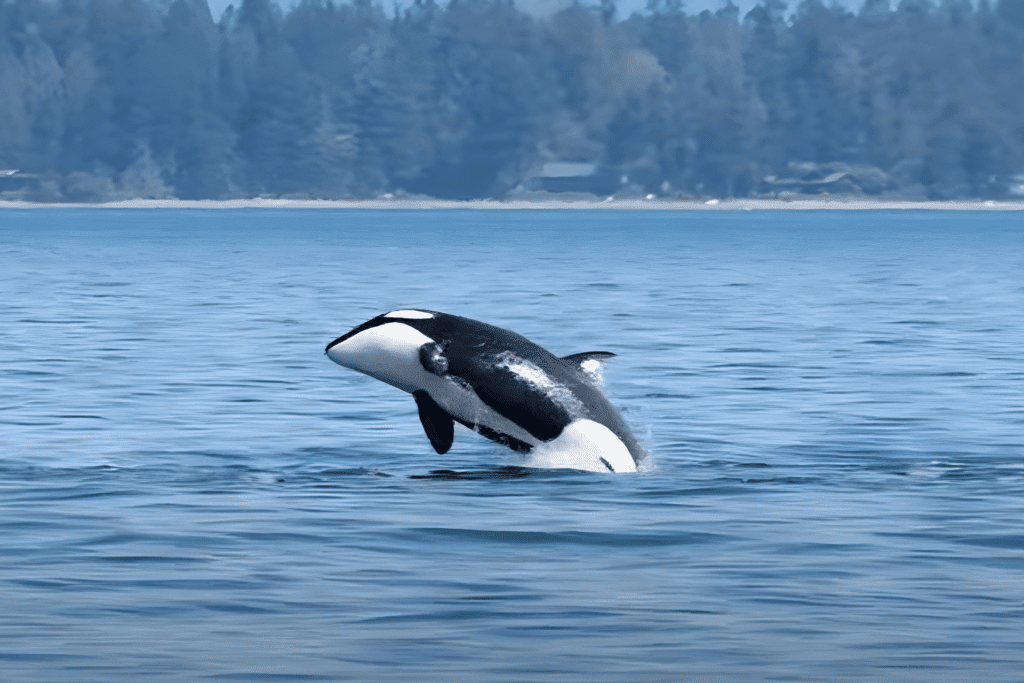

Diverse Diet
- Varied Prey: Orcas have one of the most varied diets of any marine mammal. They feed on fish, squid, seabirds, turtles, octopuses, and even larger mammals like seals, sea lions, and other whale species.
- Specialized Diets: Different orca populations may specialize in certain types of prey. For instance, some pods primarily hunt fish, while others are more adept at hunting marine mammals.
- Regional Preferences: The diet of orcas also varies depending on their location. In some regions, they might feed predominantly on salmon, while in others, they might hunt larger prey like minke whales.
The hunting prowess of orcas is not just a display of their physical capabilities but also a reflection of their high intelligence and social complexity. Their ability to adapt their hunting techniques to different prey and environments is a key factor in their success as top predators in the marine world. Understanding these aspects of orca behavior helps us appreciate the depth of their intelligence and their important role in the ocean’s ecosystems.
Orcas in Different Environments
Different Types of Orca Populations
Orcas, with their global distribution, exhibit fascinating variations in behavior and diet depending on their environment. Broadly categorized into resident, transient, and offshore groups, each type of orca population has distinct characteristics and lifestyles.
- Resident Orcas: These orcas are typically found in coastal waters and have a more stable, defined home range. Resident orcas are known for their complex vocalizations and strong pod structures. They primarily feed on fish, with a particular preference for salmon. The social structure of resident orcas is matriarchal, and they tend to live in larger, more stable groups.
- Transient (or Bigg’s) Orcas: Unlike residents, transient orcas have no fixed home range, traveling great distances across the oceans. They are more solitary and less vocal in nature, likely as a hunting adaptation to avoid alerting their prey. Transient orcas primarily feed on marine mammals, including seals, sea lions, and occasionally other whale species. Their pods are usually smaller and less stable than those of resident orcas.
- Offshore Orcas: These orcas are less studied and understood. They are typically found in deeper, offshore waters. Offshore orcas have a varied diet that includes fish and sharks. They are known to have distinct physical characteristics, such as smaller dorsal fins and different tooth wear patterns, likely due to their unique diet.
Behavioral and Dietary Differences Based on Environment
- Adaptation to Prey: The primary factor influencing the behavior and diet of different orca groups is their prey. Residents’ fishing specialization requires different hunting techniques and social structures compared to transients, who hunt more elusive and challenging marine mammals.
- Vocal Communication: Resident orcas use various vocalizations for communication and coordination, which is especially important in their fish hunts. In contrast, transients are quieter likely to avoid alerting their mammalian prey.
- Social Structure: The social dynamics of orcas also vary with their environment. Resident orcas have larger, more cohesive family groups, while transients form smaller, more fluid groups. This difference reflects the nature of their respective hunting strategies and social interactions.
- Cultural Differences: There is evidence to suggest that different orca groups have distinct cultures, particularly in terms of vocalizations, hunting techniques, and social behaviors. These cultural aspects are passed down through generations and are key to their survival in diverse environments.
Understanding the differences among resident, transient, and offshore orcas offers a glimpse into the adaptability and diversity of these remarkable marine mammals. It highlights the importance of tailored conservation efforts considering the specific needs and threats each type of orca population faces.
Orcas and Human Interaction
Orcas have long been significant in human culture, symbolizing various aspects of life and nature in folklore and popular culture. However, as our understanding of these majestic creatures grows, so does our recognition of the need for their conservation and humans’ impact on their lives.
Orcas in Folklore and Popular Culture
- Cultural Significance: In many indigenous cultures, especially those in the Pacific Northwest, orcas are revered and considered sacred. They often appear in myths and legends, symbolizing strength, intelligence, and community.
- Representation in Art: Orcas are a popular subject in art, from traditional totem poles and carvings to contemporary paintings and sculptures. They are often depicted as powerful yet graceful beings, embodying the mystery and majesty of the ocean.
- Popular Media: In modern times, orcas have captured the public’s imagination through documentaries, movies, and books. They are often portrayed as intelligent and social animals, sparking interest and empathy among audiences worldwide.
The Importance of Orca Conservation
- Threats from Human Activities: Orcas face several threats from human activities, including pollution, overfishing, and habitat destruction. Noise pollution from ships and marine traffic also disrupts their communication and navigation.
- Conservation Efforts: Recognizing these threats, various conservation efforts are underway to protect orcas. These include establishing marine protected areas, regulating fishing practices, and reducing ocean pollution.
- Public Awareness: The growing public interest in orcas has led to increased awareness of the need for their conservation. Many organizations and documentaries focus on educating the public about orcas’ challenges and how to help protect them.
Human Impact on Orcas’ Lives
- Changing Ecosystems: Human-induced climate change is altering ocean ecosystems, affecting prey availability for orcas and forcing them to adapt to changing conditions.
- Captivity and Entertainment: The practice of keeping orcas in captivity for entertainment has been a controversial issue. It has sparked debates about the ethical implications and the psychological and physical impact on these highly intelligent creatures.
- Research and Understanding: Increased research on orcas, facilitated by interest in their conservation, has led to a better understanding of their needs and behaviors. This knowledge is crucial for developing effective conservation strategies.
In summary, orcas are significant in human culture, from ancient folklore to modern conservation efforts. As we continue to learn about these magnificent creatures, it becomes increasingly important to consider our impact on their lives and the urgent need to protect them and their habitats.
From Myth to Art: Whales in Human Culture
Whales have long captured human imagination, featuring prominently in various myths, legends, and cultural expressions. While many of these stories and uses are awe-inspiring and profound, some veefwilr into the more amusing and peculiar, especially when it comes to the more unusual aspects, like whale penises.
Amusing Myths and Legends Involving Whale Penises:
- Throughout history, certain cultures have had myths and folklore where whale penises played a role, often symbolizing strength, fertility, or the untamed power of the sea.
- In some Norse legends, the size and strength of a whale penis were exaggerated to mythical proportions, often used in humorous tales to entertain and amuse listeners.
- In certain coastal communities, there were beliefs that sighting a whale penis was an omen of good fortune, particularly for fishermen, as it was thought to predict a bountiful catch.
Odd and Humorous Uses in History or Art:
- Historically, some parts of a whale, including the penis, were used in various practical applications due to their size and durability. For instance, in some cultures, the skin of a whale’s penis was used to make robust and waterproof covers for valuable items.
- In art, whale penises are occasionally featured in a symbolic manner, sometimes used in caricatures or satirical pieces to represent excess or gluttony.
- In more modern times, the sheer size of a whale penis has been a subject of curiosity and humor in certain artistic circles, leading to its inclusion in some contemporary art pieces and installations, often as a commentary on environmental issues or human-animal relationships.
While these aspects of whale-related myths and art might seem odd or humorous, they reflect the diverse ways in which humans have related to these majestic creatures throughout history. From reverence to amusement, whales have been a constant source of inspiration and intrigue in human culture.
Experiencing Orcas in the Wild
Witnessing orcas in their natural habitat is an awe-inspiring experience, offering a unique opportunity to connect with these majestic creatures. However, it’s crucial to approach whale watching with a sense of responsibility and respect for the orcas’ environment and well-being.
How to Responsibly Watch Orcas in Their Natural Habitat:
- Choose Certified Operators: Select certified whale-watching tours that follow responsible wildlife viewing guidelines. These operators prioritize the safety and well-being of the orcas and are knowledgeable about their behaviors and needs.
- Maintain a Safe Distance: Always keep a respectful distance from the orcas. Encroaching too close can disturb their natural behaviors and stress the animals. Responsible whale-watching guidelines typically specify minimum distances to maintain from the wildlife.
- Avoid Chasing or Encircling Orcas: Never pursue or encircle orcas. If an orca approaches your boat, remain calm and maintain a steady course at a slow speed, allowing the animal to pass safely.
- Limit Viewing Time: Spending too much time with a single group of orcas can disrupt their daily routines. Limit your viewing time to the duration recommended by guidelines or your tour operator.
- Silence is Golden: Reduce noise pollution by turning off engines when appropriate and keeping voices low. Orcas rely heavily on sound for communication and navigation; excessive noise can interfere with these processes.
Encouraging Eco-Friendly Practices in Whale Watching:
- Educate and Inform: Tour operators and guides should educate their guests about orcas and the importance of conservation, fostering a deeper understanding and respect for these animals.
- Support Conservation Efforts: Participate in or support programs and initiatives contributing to orca research and conservation. This can include citizen science projects, donations, or volunteering.
- Promote Sustainable Practices: Encourage practices that reduce environmental impact, such as using eco-friendly boats or minimizing waste and pollution during tours.
- Advocate for Protection: Support policies and regulations that protect orcas and their habitats. This can involve advocating for marine protected areas, stricter pollution controls, and sustainable fishing practices.
Conservation Efforts
- International Whaling Commission (IWC): The IWC regulates whaling activities and promotes whale conservation. [1]
- Marine Protected Areas (MPAs): Establishing MPAs helps protect crucial whale feeding and breeding grounds. [2]
- Species-Specific Conservation Programs: Programs targeting specific species or populations are critical, especially for at-risk populations.
- Research and Monitoring: Ongoing research is essential for understanding whale populations and the impacts of various threats. This information is crucial for effective conservation strategies.
- Public Awareness and Education: Educating the public about whales and their threats is vital for garnering support for conservation efforts.
- Collaboration with Fisheries: Working with the fishing industry to develop whale-safe fishing gear and practices can significantly reduce entanglement deaths.

